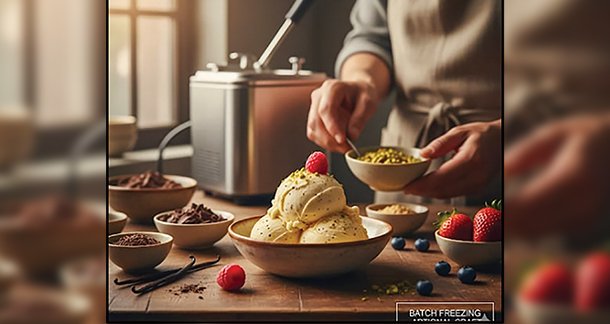INTRODUCTION
Ice cream is more than just a dessert; it’s a time machine of memories, a comfort blanket, and a celebration of childhood. It always feels right no matter whether it’s a hot summer day or a chilly winter evening. But have you noticed how one scoop feels thick and creamy, while another feels light and airy? That difference lies in how they are frozen. One is like a slow dance, the other a sprint. The ice cream industry mainly uses two different methods: batch freezing and continuous freezing, which influence its ice crystal size, texture, and how well air mixes in. Both are significant in the ice cream industry, but they differ in scale, texture, and purpose. Freezing of ice cream affects more than just its temperature. It decides if ice cream is smooth and creamy or icy and firm. This occurs because freezing controls ice crystal formation and the amount of air mixed in. In ice cream terms, this air is referred to as “overrun.” If there’s not enough air, the ice cream becomes dense. If there’s too much air, it turns too fluffy.
- Batch Freezing
The traditional way of making ice cream is to freeze it in batches. In this method, a certain amount of liquid mix is placed in a batch freezer. While stirring, the freezer cools the mix. This process helps extractheat,break ice crystals, and add some air to the mix. When the mix is the right texture, the batch is taken out and put away. Ice cream made with this method is thick, rich, and creamy. Compared to industrial ice cream, batch-frozen products contain less air, which enhances their stronger flavors. Small businesses and artisanal brands often used batch freezing to provide their clients a unique experience. This way gelato shops make fresh ice cream every day. However, it does have some limitations, for large-scale production, it is time-consuming and expensive because each cycle can only produce a certain amount. Also, quality may be a little different from batch to batch depending on the skills of the operator. But it remains a fan favourite for those who like its uniqueness, variety, and authentic taste.

- Continuous Freezing
Large factories and ice cream companies around the world use the continuous freezing method. In this system, the ice cream mix flows continuously into a machine that cools and mixes it rapidly. Air is added in a controlled manner, which creates a lighter, more uniform texture. The main benefit of continuous freezing is efficiency. Every hour, factories are able to produce thousands of liters of ice cream with consistent quality and flavor. Because the whole process is automatic and machine-operated, which allows ice cream to be packaged immediately after freezing, which makes it easy to store and transport. However, continuous freezing also has some limitations. The higher air content may result in ice cream that feels less creamy than batch-frozen options. And this method is known for its uniformity and production speed, so there is less possibility to experiment with unusual flavors or textures. However, freezing must continue to meet the global demands of the market.
- Comparison of Methods
Both freezing methods arethe most important steps in making ice cream.
- Size: Batch is mainly used by small and local brandsfor small production, while continuous is used by large industries and companies for large production at once.
- Texture: Batch producecreamier, denser, and more varietyof textured ice cream, while ice cream made from the continuous method islighter and fluffier.
- Flexibility: Batch has very high flexibility;it lets you try new things creatively, while continuous focuses on making things the same for the long run.

Conclusion
Both methods are importantin the making of ice cream; each representsthe two different sides of ice cream making inthe global market. Whether it’s a gelato scoop or a supermarket tub, the tasteof rich, creamy, and freshly madeice creamfrombatch freezingis evident initsmagic.On the other hand, a well-packaged tub of ice cream from a supermarket was made using the continuous method. Both methods are crucialfor the ice cream industry. One supports global supply and affordability, while the other preserves individuality and uniqueness. Together, they ensure that ice cream remains a favorite for everyone, whether enjoyed in small scoops or large tubs.
About Author
Rishu Riya1 and Animesh Raj2
1,2Department of Biotechnology
Gautam Buddha University, Greater Noida (U.P-201312)
*Corresponding author email: ruchiverma0715@gmail.com
REFERENCE
- Goff, H.D. & Hartel, R.W. (2013). Ice Cream. Springer.
- Clarke, C. (2012). The Science of Ice Cream. Royal Society of Chemistry.
- Arbuckle, W.S. (2017). Ice Cream (7th ed.). Springer.
- Muse, M.R. & Hartel, R.W. (2004). Ice cream structural elements that affect melting rate and hardness. Journal of Dairy Science, 87(1)pp, pp.1–10.



